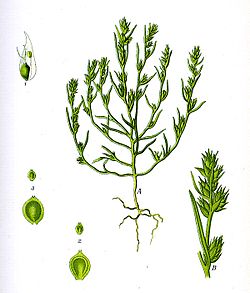| Corispermum | |
|---|---|
 | |
| Corispermum intermedium | |
| Scientific classification | |
| Kingdom: | Plantae |
| Clade: | Tracheophytes |
| Clade: | Angiosperms |
| Clade: | Eudicots |
| Order: | Caryophyllales |
| Family: | Amaranthaceae |
| Subfamily: | Corispermoideae |
| Genus: | Corispermum L. |
| Species | |
60-65: See text | |
Corispermum is a genus of plants in the family Amaranthaceae. Common names given to members of the genus involve bugseed, tickseed, and tumbleweed. In general, these are erect annual plants with flat, thin leaves and topped with inflorescences of flowers with long bracts. Bugseeds are native to North America and Eurasia, but little is known about their taxonomy and distribution.